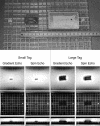Safety and reliability of Radio Frequency Identification Devices in Magnetic Resonance Imaging and Computed Tomography
- PMID: 20205829
- PMCID: PMC2825188
- DOI: 10.1186/1754-9493-4-2
Safety and reliability of Radio Frequency Identification Devices in Magnetic Resonance Imaging and Computed Tomography
Abstract
Background: Radio Frequency Identification (RFID) devices are becoming more and more essential for patient safety in hospitals. The purpose of this study was to determine patient safety, data reliability and signal loss wearing on skin RFID devices during magnetic resonance imaging (MRI) and computed tomography (CT) scanning.
Methods: Sixty RFID tags of the type I-Code SLI, 13.56 MHz, ISO 18000-3.1 were tested: Thirty type 1, an RFID tag with a 76 x 45 mm aluminum-etched antenna and 30 type 2, a tag with a 31 x 14 mm copper-etched antenna. The signal loss, material movement and heat tests were performed in a 1.5 T and a 3 T MR system. For data integrity, the tags were tested additionally during CT scanning. Standardized function tests were performed with all transponders before and after all imaging studies.
Results: There was no memory loss or data alteration in the RFID tags after MRI and CT scanning. Concerning heating (a maximum of 3.6 degrees C) and device movement (below 1 N/kg) no relevant influence was found. Concerning signal loss (artifacts 2 - 4 mm), interpretability of MR images was impaired when superficial structures such as skin, subcutaneous tissues or tendons were assessed.
Conclusions: Patients wearing RFID wristbands are safe in 1.5 T and 3 T MR scanners using normal operation mode for RF-field. The findings are specific to the RFID tags that underwent testing.
Figures





Similar articles
-
Application safety evaluation of the radio frequency identification tag under magnetic resonance imaging.Biomed Eng Online. 2014 Sep 4;13:129. doi: 10.1186/1475-925X-13-129. Biomed Eng Online. 2014. PMID: 25187420 Free PMC article.
-
Assessment of safety and interference issues of radio frequency identification devices in 0.3 Tesla magnetic resonance imaging and computed tomography.ScientificWorldJournal. 2014 Feb 16;2014:735762. doi: 10.1155/2014/735762. eCollection 2014. ScientificWorldJournal. 2014. PMID: 24701187 Free PMC article.
-
Evaluation of MRI issues for an access port with a radiofrequency identification (RFID) tag.Magn Reson Imaging. 2013 Oct;31(8):1439-44. doi: 10.1016/j.mri.2013.04.005. Epub 2013 May 16. Magn Reson Imaging. 2013. PMID: 23684963
-
Radio-frequency identification: its potential in healthcare.Health Devices. 2005 May;34(5):149-60. Health Devices. 2005. PMID: 16048121 Review.
-
Overview of RFID technology and its applications in the food industry.J Food Sci. 2009 Oct;74(8):R101-6. doi: 10.1111/j.1750-3841.2009.01323.x. J Food Sci. 2009. PMID: 19799677 Review.
Cited by
-
Application safety evaluation of the radio frequency identification tag under magnetic resonance imaging.Biomed Eng Online. 2014 Sep 4;13:129. doi: 10.1186/1475-925X-13-129. Biomed Eng Online. 2014. PMID: 25187420 Free PMC article.
-
Real-Time Person Identification in a Hospital Setting: A Systematic Review.Sensors (Basel). 2020 Jul 15;20(14):3937. doi: 10.3390/s20143937. Sensors (Basel). 2020. PMID: 32679781 Free PMC article.
-
Assessment of safety and interference issues of radio frequency identification devices in 0.3 Tesla magnetic resonance imaging and computed tomography.ScientificWorldJournal. 2014 Feb 16;2014:735762. doi: 10.1155/2014/735762. eCollection 2014. ScientificWorldJournal. 2014. PMID: 24701187 Free PMC article.
-
Systematic review of MRI safety literature in relation to radiofrequency thermal injury prevention.J Med Radiat Sci. 2024 Sep;71(3):445-460. doi: 10.1002/jmrs.800. Epub 2024 Jun 27. J Med Radiat Sci. 2024. PMID: 38937923 Free PMC article.
-
Deployment of RFID in healthcare facilities-experimental design in MRI department.J Med Syst. 2012 Dec;36(6):3423-33. doi: 10.1007/s10916-011-9796-9. Epub 2011 Nov 10. J Med Syst. 2012. PMID: 22072278
References
LinkOut - more resources
Full Text Sources

